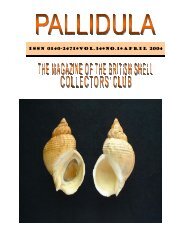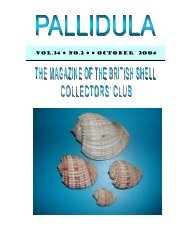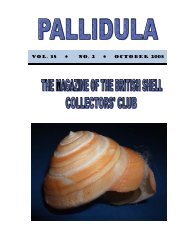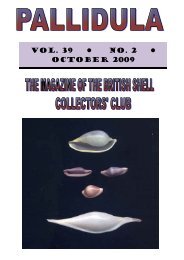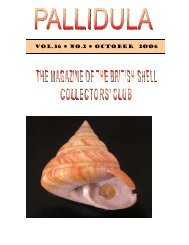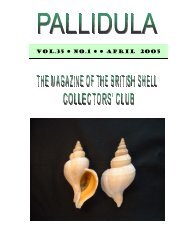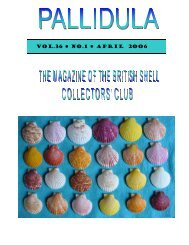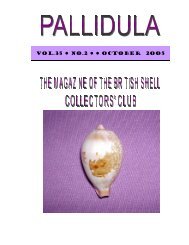VOL.37 NO.1 APRIL 2007 - British Shell Collectors' Club
VOL.37 NO.1 APRIL 2007 - British Shell Collectors' Club
VOL.37 NO.1 APRIL 2007 - British Shell Collectors' Club
You also want an ePaper? Increase the reach of your titles
YUMPU automatically turns print PDFs into web optimized ePapers that Google loves.
PALLIDULA Page 10<br />
There are decorated snuff boxes, a round box with minute<br />
mussels and green Pea <strong>Shell</strong>s, another black oval box covered<br />
in Nerita zebra and a pink oval box with soft pink cones and<br />
opercula. Sometimes Peter makes a creation as a table<br />
arrangement or ornament, such as “Temple of Venus” which is<br />
named after the Venus Comb shell from the murex family. This<br />
is set on a red platform with red pillars and white Fusinus, white<br />
murex and little green sea urchins. One box is actually a casket<br />
which is revealed from all sides by the mirrors. It is a 17 th<br />
century fabric casket, sumptuously embroidered with shells,<br />
pearl flowers and foliage in the most heavenly pink, mauves,<br />
pale greens and turquoise blues. Opened it reveals a conservatory filled with wonderfully delicate<br />
flowers and a small fountain.<br />
It is hard to choose from all the works,<br />
as to which is the most stunning,<br />
extraordinary, amazing. I would say the<br />
shell flower arrangements are a<br />
testament to Peter’s eye for detail of the<br />
natural world and selection of the best<br />
shells to create flower form. One<br />
arrangement is a spectacular seven<br />
tiered floral tower of over 100 varied<br />
flower heads and one butterfly. I confess<br />
I was so stunned at the 100 flowers<br />
I have yet to find the butterfly. These<br />
shell flower petals are made from<br />
different Tellinas, mussels, scallops,<br />
Nucellas and blue limpets, whereas sea<br />
urchins, urchin spines, small Gibbula or other tiny gastropods form the flower nucleus and stamens.<br />
Peter even makes his own leaves. Recognisable are the yellow, pink or peach roses, pink camellias,<br />
chrysanthemums, passion flowers and lilies yet all made from shells.<br />
Peter’s work is an inspiration to<br />
anyone who has too many shells of<br />
one species, or part fragments of<br />
specimens, as well as those strange<br />
fishy components left on beaches,<br />
such as, sharks teeth, jaws, urchin<br />
spines, shrimp claws, seaweed and<br />
coral. It is a must for anyone who is<br />
interested in shell art to see what can<br />
be done with time, creativity, patience<br />
and lots of artistic flair!<br />
There are postcards of the works for<br />
sale, shell books and shells suitable<br />
for shell art. The museum is open<br />
from 12 noon to 5pm daily, Thursday<br />
to Sunday, Easter to the end of<br />
September. Admission is Adults<br />
₤2.00; concessions ₤1.50;<br />
accompanied children under 16 free.<br />
For more information see the society’s website www.sheringham-preservation.org.uk



